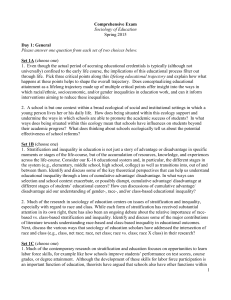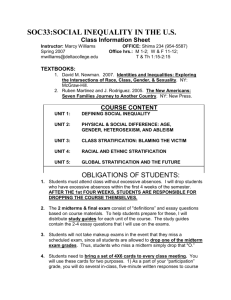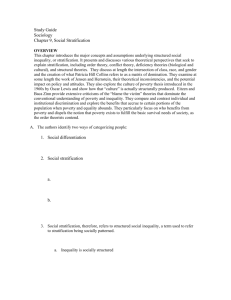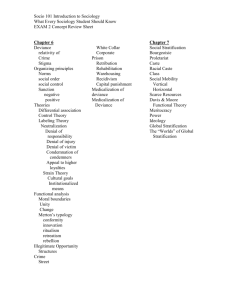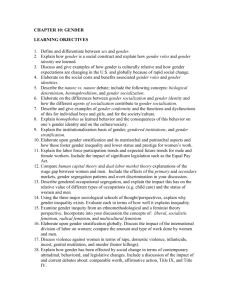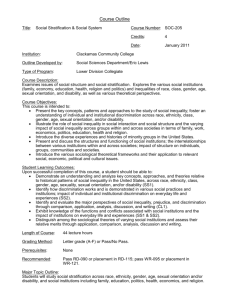Basic Concepts - Inequality and Stratification
advertisement
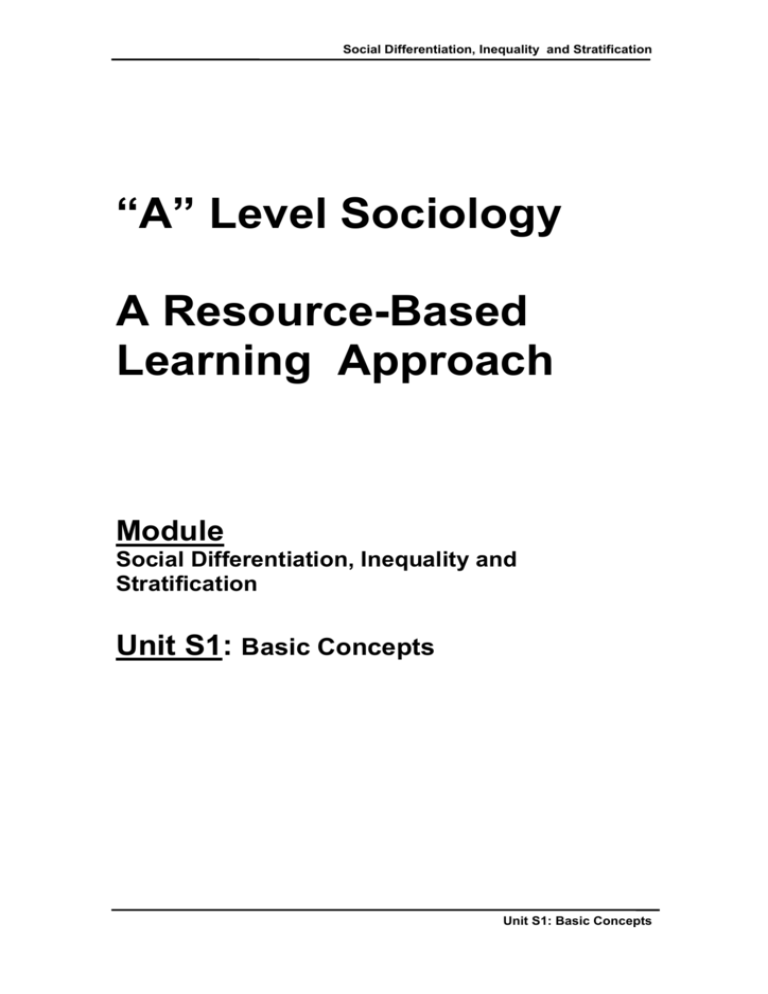
Social Differentiation, Inequality and Stratification “A” Level Sociology A Resource-Based Learning Approach Module Social Differentiation, Inequality and Stratification Unit S1: Basic Concepts Unit S1: Basic Concepts Social Differentiation, Inequality and Stratification Unit S1: Basic Concepts Introduction. The main themes of this section of the A-level course are social differentiation, social inequality and social stratification and, before we start to look in detail at the relationship between these three major sociological concepts we need to look briefly at how they can be defined. Social Differentiation. We are all aware of individual human differences which, in simple terms, we can think about in two basic ways: • Firstly, natural or biological differences, such as differences in physique, strength, hair colour and skin colour. • Secondly, social or cultural differences, such as differences in the work people do or their level of income, status and power. In this respect there are, potentially, any number of possible dimensions to human differences and the ultimate expression of this idea is to see every human individual as being uniquely different in some way. However, the fact of human difference (whether considered in terms of individuals or cultural groups) is not, in itself, particularly significant to sociologists. What is significant, however, is the meaning of these differences (whether they be real or imagined), to both our self and others. A teacher, for example, is different to the students they teach. This fact, however, is not particularly important since it simply signifies itself (that is, there is a difference between the two). However, if a teacher can direct and control the behaviour of their students because of this difference, this becomes something very important because the meaning of the relationship between two different groups (teachers and students) involves a number of significant ideas. We can, for the moment, note these in the following terms: Firstly, it involves the concept of inequality. The teacher, for example, is able to use the fact of their difference to control the behaviour of students (even if the students do not really want to conform to the teacher’s wishes). Secondly, therefore, it involves the related concepts of ideology and power. Ideology, in this respect, involves beliefs about the significance of the teacher - student difference. For example, it might involve certain values (students should obey their teacher, a teacher has the right to demand conformity from their students and the like), norms (when a teacher is talking a student keeps quiet, for example) and beliefs (it is right, for example, that a teacher should seek to control the behaviour of their students). Power, on the other hand, involves the ability to put ideas into practice. A student, for example, may believe it wrong that a teacher can punish them (verbally or physically), but if they lack the power to do anything about such punishment their beliefs are of little social consequence. Finally, it involves the concept of stratification. That is, the idea that people can be ranked differently in terms of their social importance or status. Chris.Livesey: www.sociology.org.uk Page 1 Social Differentiation, Inequality and Stratification Unit S1: Basic Concepts In this instance, the teacher is of higher social rank than the student. This fact is based on the inequality between them and, in turn, such inequality reinforces the concept of stratification (or social hierarchy - the placing of individuals / groups at different levels in society). Aside from introducing the concepts of inequality, ideology, power and social stratification, what this example tells us is that social differentiation always involves a process of “making people different”, in the sense that social characteristics are used to enhance the power of one group over another, either by emphasising the superior differences characteristic of the dominant group or by emphasising the inferior characteristics of the subject group. Social differentiation, therefore, always involves a sense of social inequality and social ranking (stratification). We can express the above ideas - and the relationship between them diagramatically in the following way: 1. “Human Differences” become 2. Social Differentiation when: 3. Ideological beliefs about human differences (explanations of the meaning and significance of these differences), combined with: 4. The power to put such beliefs into practice are used to create 5. Social Inequalities. This, in turn, always involves: 6. Social Stratification (The process whereby different social groups are ranked higher or lower on some form of equality scale). We can illustrate the above further with an example based around sex and gender. • Human Difference: In our society we recognise two biological sexes (males and females). Chris.Livesey: www.sociology.org.uk Page 2 Social Differentiation, Inequality and Stratification Unit S1: Basic Concepts • Social Differentiation occurs when we apply beliefs about what it means, in our society, to be either male or female. In this instance the characteristics we could assign to these social categories are unimportant, but a stereotypical representation might associate characteristics such as: Men: Women: Passive, Co-operative, Physically weak, Emotive, etc. Aggressive, Competitive, Physically strong, Emotionless, etc. If, for the sake of argument, we believe the above to be true, these beliefs will only be socially significant if people have the power to act on such beliefs. Historically, for example, in our society men have traditionally held the highest, most significant, positions of power. • Social Inequality occurs when ideology and power combine in such a way as to make one group superior or inferior to another group. In this respect, the fact that men have historically been more powerful than women has been reflected in different levels of social status for each group. th For example, until the late 19 century, women had no separate legal status of their own (they were, for example, legally considered to be the property of men - fathers, brothers, husbands and the like). Women could not, for example, vote, own property, divorce their husband or work in a wide range of occupations. • Where men and women are treated differently and unequally on the basis of their sex, this produces a form of social stratification (in this instance, a very basic two class model): Men (at the top of society) Women (at the bottom of society) • The significance of this, as we will see when we develop our ideas about social stratification, is that the ranking process not only reflects social differences, it also creates and maintains these differences by socialising people into a structure of inequality. Chris.Livesey: www.sociology.org.uk Page 3 Social Differentiation, Inequality and Stratification Unit S1: Basic Concepts Social Stratification. Although the idea of social differentiation is an important one, the main focus of this section of the course will be on the concept of social stratification, which we now need to develop in some detail. As always, the best place to start is with a definition of the concept. The Concise Oxford English Dictionary defines the word "strata" as: • "A layer, or set of successive layers, of any deposited substance; layer of atmosphere, biological tissue, or other structure; social grade (the various strata of society).". To stratify, therefore, involves the ability to, • "Arrange in strata; construct in layers, social grades, etc.". In this respect, we can initially see that if "stratification" involves some concept of layering (one layer being placed above or below the next - like rock layers, for example), the concept of "social stratification" involves the idea that people - either as individuals or, more usually, as groups - can be assigned to different layers (or levels) in the society in which they live. • As you should be aware, the analogy drawn between geological stratification (that is, rock layers) and social stratification (social group layers) is not a perfect one. As with all analogies, you should not be tempted to stretch them too far. The concept of stratification as it is applied to human societies is far more complex than its application to rocks, mainly because - as you will be aware - human beings have consciousness; that is, they are: • • • • Aware of their social environment. Aware of their social relationships. Affected by these relationships. Able to change these relationships. Thus, while we must use the concept of stratification critically and with care (unlike rock layers, for example, the social strata created by human beings in their social relationships are not fixed, complete in themselves and unchanging), it is nevertheless a useful starting point for the analysis of human social relationships. We can develop the above definition by noting the way in which the concept of social stratification has been defined sociologically: • Giddens (“Sociology”, 1993) for example, has defined it as: “Structured inequalities between different groupings of people”. • Crompton (“Class and Stratification”, 1993) expands this simple definition when she notes that social stratification is: “A hierarchical system of inequality (material and symbolic),always supported by a meaning system that seeks to justify inequality.”. Both of these definitions contain a number of key terms and concepts we need to briefly expand. Chris.Livesey: www.sociology.org.uk Page 4 Social Differentiation, Inequality and Stratification Unit S1: Basic Concepts • Hierarchy: This reflects the idea that social groups in any stratification system are arranged “one above the other” (symbolically, if not literally). As we will see, the basis for this hierarchical ranking is social status. This concept is defined by Lawson ( “The Complete A-Z Sociology Handbook”, 1996) as: “The honour or prestige [level of respect] given by members of a society to groups or individuals.”. • System: If something is “systematic” it means that it is not based on accident or chance; rather, it is based on some sort of design. A system of social stratification, therefore, is one built around a set of criteria that are used as the basis for 1. Defining the place of individuals / groups in a society. 2. Defining the general relationship between individuals / groups. For example, in this section of the course we will be looking at four major dimensions of social stratification, based on criteria such as: • • • • Social class Gender Ethnicity and Age The idea that social stratification can be viewed as systematic is a significant one because it means that there must be: • A purpose for a particular type of stratification (it must exist for a reason). • People who generally benefit from a particular form of social stratification. • People who generally suffer under a particular form of social stratification. In addition, it follows there will be people who have an interest in maintaining a particular system of stratification if they are to continue to benefit from its existence (which takes us back to the concepts of power and ideology). • Inequality: Any system of social stratification will, by definition, involve a sense of social inequality within and between different social groups. Although we will necessarily look at the concept of inequality (as it applies in this context) in more detail at a later point, we can note two basic types of inequality here: a. Material inequality: This relates to economic inequalities between people (such as wealth, income and so forth) and b. Symbolic inequality: This relates to less tangible things like inequalities of status (some people are valued more highly than others) and power (some people have greater control over both their life chances and the life chances of others). Chris.Livesey: www.sociology.org.uk Page 5 Social Differentiation, Inequality and Stratification Unit S1: Basic Concepts • Belief / Meaning system: In simple terms, a belief or meaning system refers to the way a set of related ideas (an ideology if you like) is always used to support, justify or explain something in the social world. A belief system, therefore, is like a mental map we use to locate our ideas about the social world - just as we use a physical map to locate our physical position in the world. For example, if we are told that someone has “given birth to a baby girl”, we use mental maps to help us explain both the meaning of concepts such as “birth”, “baby” and “girl” and, most importantly, the relationship between such ideas. In this respect, in order to understand (“make sense of”) the ideas involved we use the stock of ideas we have already have learnt through our socialisation. In addition, the concept of a “girl” involves a different set of meanings to the concept of a “boy” and the meaning system we use in relation to each will affect how we view “girls” and “boys” in our society. In the context of social stratification, the concept of a meaning system is used to show how particular forms of stratification (class, gender, ethnic, age and so forth) are always accompanied by a set of beliefs that seek to explain and justify the social inequalities between the individuals / groups involved. As an exercise, you might like to think about the types of meaning system that can be used to justify inequalities between the following groups: • • • • The very rich and the very poor in our society. Adults and children. A student at the top of the class and a student at the bottom. Teachers and students. Chris.Livesey: www.sociology.org.uk Page 6 Social Differentiation, Inequality and Stratification Unit S1: Basic Concepts Summary • Thus far we have looked at a number of aspects of social stratification which we can note and summarise in the following terms: 1. It involves broad social groups who are different in some way from each other. In simple terms this basically means that human societies invariably consist of social groups that can be defined in terms of: a. The fundamental things that the members of a group share (whatever these things may be). b. The fundamental differences between one social group and another. If you want to explore the basic logic behind this argument, read the text inside the boxes. If not, skip this page and go to the next point… The focus on social groups, rather than “individuals”, as the basic unit of analysis, is significant because of the way sociologists’ view the relationship between the individual and the society in which they live. In simple terms, “individual human beings” are the product of the world in which they live; that is, they are shaped by the experience of “living with others”. If you think about it, it’s not possible to define an “individual human being” other than by reference to the groups to which they belong. Test this idea by thinking about how you would define yourself “as an individual” (you might like to think about how you could do this without language, something you have learnt from others…) The point here is that although we, as unique individuals, all have consciousness (an awareness of ourselves, others and the significance of our relationships) we can only define ourselves collectively (that is, we use the fact of our consciousness to understand our relationship to others and, by so doing, define who and what we are). If each individual is (simply) the product of the groups to which they belong than it makes sense, logically, to analyse “people as social groups” rather than “people as individuals” (since the later is wholly dependent on the former). To argue "everyone is an individual and everyone is different" may be true, in a very limited sense, but it ignores the fact that we are only "individuals" because of the way we interact socially with other people. It is the fact of our membership of social groups that gives us the ability to recognise ourselves as individuals in the first place. All "individual behaviour", therefore, is based on the way we recognise our relationship to other individuals. If this seems a bit complicated to grasp, try thinking about the following ideas: Chris.Livesey: www.sociology.org.uk Page 7 Social Differentiation, Inequality and Stratification Human beings live in groups (small groups like families, larger groups like communities or countries (“Nation States”) or even the largest group of all, humanity - membership of a social group that is global in its significance). Whether we like it or not, the fact that we are forced to live in and amongst social groups means we are affected, in some way, by the behaviour of others (just as we, in turn, affect their behaviour). Unit S1: Basic Concepts We become human individuals through social interaction with others. Our membership of social groups is not something that “just happens” because we are around others. It is through our group membership that we learn and develop our individual humanity (through a process of primary and secondary socialisation, for example). Within and between different societies there are a wide-range of cultural similarities. Notwithstanding the fact that we are all individually different, we seem to act in broadly similar ways. This is true on two levels: On a cultural level we can identify, to use G.P.Murdock’s phrase, a large number of “cultural universals”. These are things that seem to be present in every known society (family groups, religious beliefs, status differences, social controls and so forth). On an individual level we can identify numerous broad patterns of behaviour, ranging from the way we organise our time (work, leisure and so forth), to the way we speak, dress and wear our hair. • On an individual level we can identify As we know, these broad behavioural patterns (based on cultural values, roles, norms and so forth) are not accidental (even though we rarely, if ever, give them much thought) and they are not random (based on chance). We observe behavioural norms because we find them useful and helpful (liberating) or because we are compelled to obey them (our behaviour is socially controlled in some way - either by ourselves or by others…). Chris.Livesey: www.sociology.org.uk Page 8 Social Differentiation, Inequality and Stratification Unit S1: Basic Concepts 2. It involves the arrangement of social groups in a hierarchy. The concept of stratification, by definition, involves one group of people being placed higher or lower on some sort of measuring scale than another group; that is, various groups are arranged hierarchically in society on the basis of various perceived social differences. 3. It involves some concept of inequality. When we talk about any kind of "hierarchy" (social or otherwise) we are immediately introducing some notion of inequality, since to talk about one group being "higher or lower" than another group involves making judgements about these groups. Once we start making such judgements (whether or not these are justifiable, reliable, valid and so forth), we introduce notions of inequality based upon social differences. In this respect, the differences between social groups are only socially significant when they are used to treat people differently; a form of social inequality. For example, it only matters if people are categorised as “right handed” or “left handed” when this perceived difference results in the differential treatment of each group. Similarly, it is of no particular social significance whether someone is male or female until we treat such people differently on the basis of this label. When we, for whatever reason, identify a social group, compare them (favourably or unfavourably) with another group and treat each differently we are moving away from the concept of social differences and towards that of social stratification. 4. It involves some concept of power. It is evident that if we are: a. Identifying social differences between groups of people. b. Making judgements about their respective social worth (arranging them in a system of stratification) then some concept of power is also important here - if only for the fact that by arranging people in a hierarchy (on the basis of judgements we make about social differences) we are exercising some form of power. 5. It involves some concept of ideology, which is significant in a number of ways: a. All stratification systems have to be based on ideas about the meaning of social differences. b. Any system of stratification always has an associated belief system that is used to both justify and explain why such a system exists. c. Ideology is an important aspect of power, since if you can persuade someone they are inferior to, this gives you a measure of power over them. As an exercise, we can think about social stratification - and in particular it's significance and consequences - by using a form of "stratification experience" with which you are all familiar, namely "education". Chris.Livesey: www.sociology.org.uk Page 9 Social Differentiation, Inequality and Stratification Unit S1: Basic Concepts Social Stratification in the Classroom... Read and consider the following: "At some point in their school life, every student suffers an examination - a test of what you know (or, more likely what you don't know or didn't bother to revise because "they're never going to ask me a question on that")...Revising for exams is bad enough, but far worse is the feeling of barely-repressed doom when the teacher, in full view of your classmates, looks at you and utters a disapproving "tut-tut" as they hand you back your sadly-thin answer paper. It's at this point that your heart begins to beat louder and louder until your chest is pounding like the scene in "Alien" when the creature bursts out of it's victim's chest... With mounting trepidation, you lift your resigned eyes to look at the thick red mark burning it's way from the page into your heart and then you realise, with a crushing finality, that there is, after all your hopes and prayers, no God in His heaven (because if there were He would surely have answered those prayers and turned your sad scrawl into a perfectly presented, perfectly correct, set of answers). Until this awful moment of truth all students are created equal; until this fatal confirmation of your inadequacy, you could stand tall(ish) with the rest because, whatever anyone else may have suspected, there was no proof. But now there is proof, in the black and white (or, in reality, the green and mauve because you had to borrow a pen from someone) and red of the paper that has frozen in your hand... If this initial confirmation of your worthlessness was not enough, the torture continues when your “friends” start to pester you for your score and the world resounds to the scornful "beat you, beat her" mantra of a classroom full of scared students. Somewhere in the back of your mind, you hear the words, "And your exam results shall follow you all the rest of your days", and while you try not to think about it as you smile that unconvincing smile through the pain and the Herculean effort involved in stopping your face crumpling into tears, it's true. They do." From the above passage it's possible to identify the various aspects of stratification that we identified earlier. See if you can identify the following elements and provide brief examples to support your identification: a. Social differentiation d. Power b. Hierarchy e. Ideology c. Inequality If you’re interested, the examples I would give are as follows (you may have different examples that are just as valid). a. Social differentiation (making people different) is evidenced by the examination itself. Whether this differentiation is based upon some form of "objective" feature of Chris.Livesey: www.sociology.org.uk Page 10 Social Differentiation, Inequality and Stratification Unit S1: Basic Concepts behaviour (for example, the knowledge / intelligence you possess) or otherwise, the examination serves to "make people different". b. Hierarchy is evidenced by the way in which students are grouped on the basis of their test scores. In this instance, students are ranked individually (although the teacher will probably have devised very general categories - pass or fail, perhaps - in order to group students together). As you need to note, this hierarchy is not without it's consequences, since the individual's knowledge of being placed in some form of rank order affects their behaviour. c. Inequality is evidenced in the outcome of the test and it's consequences for the individual. In this instance, some students are held in higher standing than others (those that did well felt superior to those who did not do well). Even in this little example, the significance of "making people appear unequal" is clear (even though we have no evidence about the kind or importance of the test - the individual relating the story might, for all we know, be a genius in a class of similarly gifted individuals - it is clear that this person felt themselves to be of lesser worth than his or her peers... d. Power is evidenced in two main ways in this example. Firstly and most obviously in terms of the power of the teacher to rank individual students in terms of their test performance. Secondly, however, it is also evident that the relationship between the students was changed by the examination - from one of equality to inequality. While we could delve much deeper into this area if we so desired (to talk about the sources and varieties of power involved within the classroom), it should suffice for the moment simply to note various power relationships and their consequences for social stratification in this particular context. e. Ideology is evidenced in a number of different ways here: Firstly there is the belief that an examination system is an acceptable way of differentiating between individual students. This idea is presumably shared by both teacher and student. Secondly, there is the belief that exams test real differences (in intelligence for example) between different students and that they therefore represent a valid way of identifying real differences. Thirdly, In order for you to care about your exam results you have to be convinced of the importance of an examination system. Page 11



